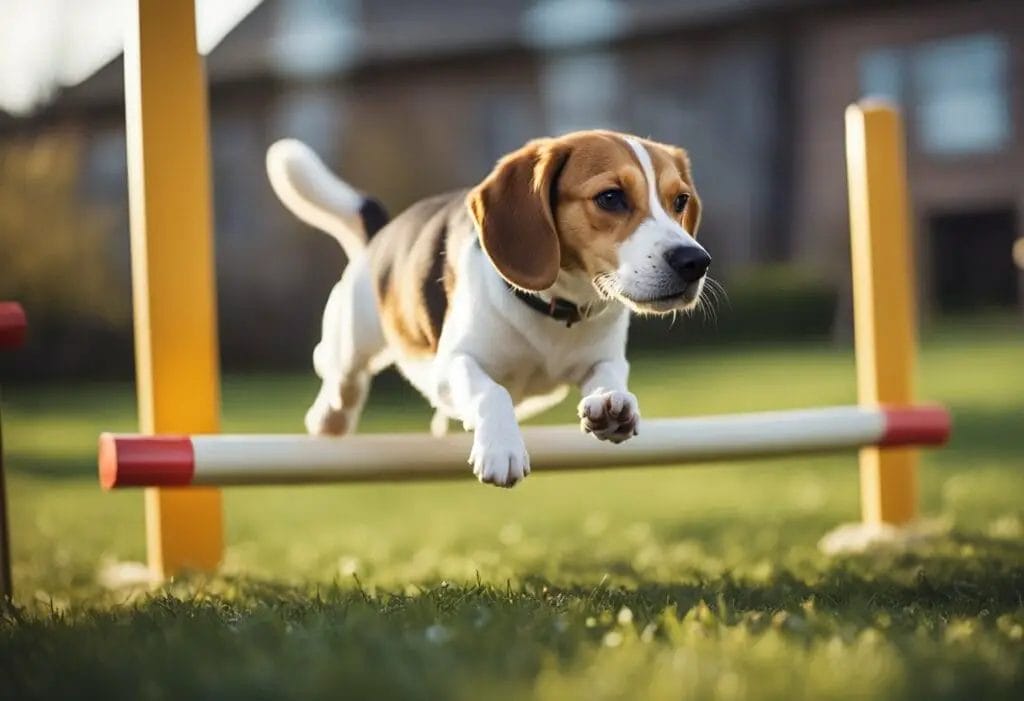Making a DIY agility course for my Beagle at home was one of the best decisions I have made. Not only did it provide a fun activity for my friend, but it also strengthened our bond and helped him gain confidence through agility training. The best part? It was easy and affordable to create.

To start, I researched different types of agility equipment and decided on a few key obstacles that would be perfect for my Beagle’s size and skill level. I found that using PVC pipes and fittings was a great option for creating jumps, weave poles, and a teeter-totter. With some basic tools and a little bit of time, I was able to assemble the equipment and set up a course in my backyard.
Not only does this DIY agility course provide a fun and challenging activity for my Beagle, but it also gives him the exercise he needs to stay healthy and happy. Plus, the confidence he gains through agility training translates to other areas of his life, making him a happier and more well-rounded dog overall.
If you’re looking for a fun and affordable way to bond with your Beagle and provide them with some much-needed exercise, I highly recommend making a DIY agility course at home.
Planning Your Agility Course
Before getting started, I had to plan the course to make sure that it would be safe and suitable for my Beagle’s size and abilities. Here are some things to consider when planning your DIY agility course.
Space Considerations
The first thing to consider is the amount of space you have available. Beagles are small to medium-sized dogs, so you don’t need a large backyard to create an agility course. However, you should make sure that there is enough space for your Beagle to run around and complete each obstacle safely. A good rule of thumb is to have at least 25 feet by 30 feet of open space.
Choosing Appropriate Equipment
When it comes to equipment, there are many options available. PVC pipes are a popular choice for DIY agility courses because they are affordable and easy to work with. However, you should also consider other materials such as wood and metal. Make sure that the equipment you choose is appropriate for your Beagle’s size and abilities. For example, you don’t want to create obstacles that are too high or too difficult for your Beagle to navigate.
Budgeting for DIY Agility Course
Creating a DIY agility course can be affordable, but it’s important to budget for the materials you’ll need. The cost will depend on the size of your course and the materials you choose. PVC pipes are a cost-effective option, and you can expect to spend around $175 for a small course. However, if you want to create a larger course with more complex obstacles, you may need to spend more.
In conclusion, planning your DIY agility course is an important step in creating a fun and engaging space for your Beagle. By considering space, equipment, and budget, you can create an affordable and safe agility course that your furry friend will love.
Building the Agility Course
When it comes to building a DIY agility course for my beagle, I like to start by creating a list of all the obstacles I want to include. Once I have a clear idea of what I want to build, I can start gathering the necessary materials.
Creating Jumps
One of the most common obstacles in any agility course is the jump. To create a standard jump, I use PVC pipes, connectors, and cups. I cut the pipes to the desired length using a pull saw, then connect them using the connectors. I secure the cups to the top of the jump using bolts and nuts. For added stability, I use woodblocks or cinder blocks as a base.
Setting Up Weave Poles
Weave poles are another popular obstacle in agility courses. To make weave poles, I use PVC pipes and connectors. I cut the pipes to the desired length using a pull saw, then connect them using the connectors. I place the poles in the ground, spacing them according to the size of my beagle. I use gravel or sand to secure them in place.
Constructing Tunnels
Tunnels are a fun and challenging obstacle for any agility course. To create a tunnel, I use a hula hoop and a sturdy fabric such as canvas or a tarp. I cut the fabric to the desired length and width, then sew it together to form a tube. I attach the tube to the hula hoop using zip ties or rope.
Making an A-Frame
An A-frame is a popular obstacle that requires balance and agility. To make an A-frame, I use PVC pipes and connectors. I cut the pipes to the desired length using a pull saw, then connect them using the connectors. I use woodblocks or cinder blocks as a base for added stability. I attach the PVC frame to a sturdy board using bolts and nuts.
Building a Pause Table
A pause table is a great way to give your beagle a break during an agility course. To make a pause table, I use a sturdy board and PVC pipes. I cut the pipes to the desired length using a pull saw, then connect them using the connectors. I attach the PVC frame to the board using bolts and nuts. I place the table at a height that is comfortable for my beagle to jump onto.
Building a DIY agility course for my beagle is a fun and rewarding experience. By using PVC pipes, connectors, and other materials, I can create a variety of obstacles that challenge my beagle’s agility and intelligence. With a little creativity and hard work, I can give my beagle the exercise and mental stimulation he needs to stay happy and healthy.
Training Your Beagle for Agility
Agility training is a fun and exciting way to bond with your Beagle while also providing them with mental stimulation and physical exercise. Before starting any agility training, it’s important to ensure that your Beagle is in good health and has basic obedience training.
Basic Commands
The first step in agility training is to teach your Beagle basic commands such as sit, stay, come, and heel. These commands will be essential in guiding your Beagle through the agility course and keeping them safe. Positive reinforcement is key when teaching these commands, and treats and praise will go a long way in helping your Beagle understand what you are asking of them.
Advanced Training Techniques
Once your Beagle has mastered the basic commands, you can begin to introduce more advanced training techniques such as obstacle training, balance training, and confidence building exercises.
Obstacle training involves introducing your Beagle to the various agility equipment such as jumps, tunnels, and weave poles. Balance training can be achieved through exercises such as walking on a balance beam or wobble board. Confidence building exercises can include introducing your Beagle to new environments and experiences such as different surfaces and noises.
When introducing your Beagle to new training techniques, it’s important to start slowly and build up gradually. Patience and consistency are key, and it’s important to always end each training session on a positive note.
Agility Equipment
When it comes to agility equipment, there are many options available for DIY enthusiasts. PVC pipes can be used to create jumps, weave poles, and teeter-totters. Cardboard boxes can be used to create tunnels, and a simple balance beam can be made out of a wooden board. It’s important to ensure that all equipment is sturdy and safe for your Beagle to use.
Safety Precautions and Benefits

Here are some safety precautions to take into consideration before setting up your DIY agility course at home.
Ensuring Safety
Firstly, make sure that the course is set up in a secure area, free from hazards or potential dangers. Keep in mind that beagles are small dogs, so ensure that the equipment is the right size and height for them. Collapsible equipment such as A-frames should be avoided, as they may cause injury to your beagle’s joints.
Supervise your pet during training sessions, and use proper techniques to prevent injuries. Start with basic exercises and gradually increase the difficulty level to prevent overexertion or fatigue. Positive reinforcement techniques can help build trust between you and your beagle, making training sessions more enjoyable for both of you.
Physical and Mental Benefits
Agility training provides many physical and mental benefits for your beagle. It can help build muscles, improve endurance and flexibility, and prevent hip problems. Regular training sessions can also provide mental stimulation, which can help keep your beagle happy and healthy.
Moreover, agility training can be a great bonding time for you and your beagle. It can help build trust and strengthen your relationship, making it a fun and rewarding experience for both of you.
Agility training is a great way to bond with your Beagle while also providing them with mental stimulation and physical exercise. By starting with basic commands and gradually introducing more advanced training techniques, you can help your Beagle become a confident and skilled agility dog.
